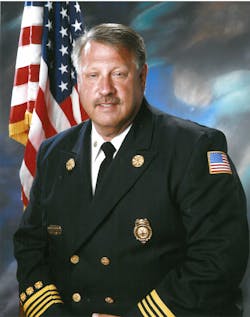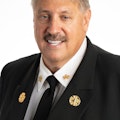I am a student of history. I particularly love listening to or reading books related to 19th and 20th century leaders, wars, geopolitical struggles and historical events. One thing I have come to know through my readings is that nothing seems to be revolutionary; everything seems to be evolutionary. And this concept absolutely applies to the delivery of fire-based EMS.
It is amazing to think of where we have been and where we might be going. What will fire-based EMS look like in 10 years—in 2025? I can only guess, but I have a pretty good idea. How? Based on a look at the past—and how everything we do is evolutionary and not revolutionary—each step on the rung up the ladder seems to change things ever so slightly and tweak it to make things better. Let’s consider that as we envision the future of fire-based EMS. But first, a brief history lesson.
Origin story
Many of us got a good idea what fire-based EMS looked like in 1972 when Emergency! glowed through our TV sets on Saturday evenings. But Los Angeles County was not the only place these new “paramedics” were delivering medical care outside a hospital environment. In other fire departments— Los Angles City, Seattle, Miami, Jacksonville (FL) and Columbus (Ohio)—pilot programs were teaching firefighters how to speak like doctors. And although these were some of the first systems to teach firefighters how to be paramedics, some departments had been operating an ambulance service for quite some time—specifically, Los Angeles City in 1927 and Chicago in 1928.
The development of all of these systems was evolutionary. Some of the changes took place when defibrillation came about in 1948. The first documented case of defibrillation outside a hospital occurred in Miami in June 1969. The victim collapsed near Fire Station 1 on the fringes of downtown. The victim was a 60-year-old male who was well known to fire personnel, as he was an alcoholic who lived in less-than-standard housing in a bad part of town and was the frequent subject of 9-1-1 calls.
The details: Miami Fire & Rescue got a call for a man down. Fire personnel put the paddles on him and determined he was in ventricular fibrillation. They defibrillated him and began CPR. Shortly thereafter, he returned to a normal sinus rhythm and was transported to a local emergency room. Three days later, he was discharged from the hospital neurologically intact. About a week later he came to Station 1 to meet the people who saved his life—and he had not been drinking. Going forward he would stop by the firehouse periodically just to say hello.
What really helped propel the fire-based EMS systems of the 1970s were the evolutionary events of the 1960s. In 1960 John F. Kennedy declared that, "Traffic accidents constitute one of the greatest, perhaps the greatest, of the nation's public health problems.” Then in 1966 Lynden B. Johnson—using a President's Commission on Highway Safety/National Academy of Sciences—declared that accidental injuries outside the hospital were "the neglected disease of modern society." That same year, Johnson received a report titled, “Accidental Death and Disability: The Neglected Disease of Modern Society,” which identified accidental injuries as the “leading cause of death in the first half of life’s span.”
Shocking statistics in the report said that in 1965 alone, vehicle accidents killed more Americans than were lost in the Korean War. When evaluating prehospital emergency care, the report identified that “if seriously wounded … chances of survival would be better in the zone of combat than on the average city street.” Additionally, the report identified a lack of regulation or standards for ambulance operations or provider training.
Generally known as “the White Paper,” this report made several recommendations for the prevention and management of accidental injuries, including the standardization of emergency training for “rescue squad personnel, policemen, firemen and ambulance attendants.” This standardization led to the first nationally recognized curriculum for EMS—emergency medical technician–ambulance (EMT-A)—which was published in 1969.
Since then, there have been several revisions to the National Standard Curriculum for EMTs and paramedics. Now we have the National EMS Education Standards. The Standards replace the National Standard Curriculum, which have been the foundation of EMS training for years. The goal is to support the ongoing transition from a limited focus on training to a more complete educational perspective. This has been another step up the rung of the ladder in the evolutionary development of EMS.
Educated guesses
While I cannot predict exactly how the future will look 10 years from now, based on evolutionary developments, I can make some educated guesses, some related to the overall system:
Auto accident response: Don’t expect to respond to auto accidents as often. Several different companies are currently working on advanced driver assistance systems (ADAS) that are designed to prevent auto collisions. Other companies with big names and deep pockets are also using this technology to develop driverless cars. Ten years from now, it may be common to see a car where the front seat and back face each other and there’s a table in the middle where you can work, read your paper or watch TV while your car drives you to your destination. Some contend there will be no need for auto insurance in the future—or even a driver’s license.
The 9-1-1 response system: The current trend seems to be moving away from the 50-year-old model of a patient calling 9-1-1 and an ambulance responding and transporting to the ER, regardless of the chief complaint. Have some pain from arthritis in your hands? We’ll send an ambulance to your home and, depending on the system, maybe even a fire engine, then take you in an ambulance to the local emergency room, where the doctor will X-ray your hand to make sure there is no other injury and he’ll write you a prescription for pain. What could have been a trip to your local Walgreens or CVS for a $5.99 bottle of Tylenol or Motrin now turns into a $750 ambulance ride plus probably more than $1,500 for an emergency room visit.
Mobile Integrated Healthcare (MIH): Fire-based EMS systems are starting to explore the possibilities of MIH. We’re still new in the development of what it will look like and what the standards will be, but in 10 years, MIH will probably focus on three areas:
- Calls will be screened at the initial answering point in the 9-1-1 communications center. Low-acuity calls will be rerouted to some other form of care that could include a nurse, doctor or physician assistant who determines whether an ambulance is needed. They may choose to make an appointment for the caller at a clinic and arrange for a taxi to pick them up 30 minutes before the appointment.
- “Treat and release” programs will handle those calls where there is an immediate need that cannot wait but that does not need an emergency room visit. A prime example of this would be someone who has a small laceration that needs cleaning and suturing. Physician assistants or nurse practitioners working with firefighter/paramedics would respond to the scene and provide services. One of the biggest benefactors of these programs could be patients with mental issues who have gone off their medication or need to be placed on medication.
- After-hospital care will be set up for those patients who have been discharged from the hospital with the goal of preventing readmissions.
As these programs evolve, it is imperative that fire-based EMS systems also share the dollar savings that come with not transporting everyone to the hospital. We certainly should not be engaged in programs that result in monetary savings without insurance providers, Account Care Organizations, or hospital systems sharing their savings with those who are saving them the money.
All about tech
Technology will have evolved to make the firefighter/paramedics job easier.
On-board systems: Expect your on-board computer systems to integrate with highway or your streets department’s computer to show you the quickest and safest route to the scene based on what their computers show with traffic flow, trains stopped at crossings or, if inclement weather, what has already been plowed and salted. You may even have a driverless ambulance one day.
Patient monitoring: New sophisticated instruments and stretchers will allow firefighter/paramedics to monitor a patient’s status. Expect to be able to simultaneously monitor a patient’s pulse, blood pressure, respiration rate, pulse oximetry, blood chemistry, EKG, carbon monoxide levels and defibrillate—all while using comprehensive data management systems with a long battery life. I also imagine that we will have devices that can scan a patient’s chest or abdomen and determine the presence of blood, a pneumothorax, where a bullet is lodged, or even large amounts of gas that could be causing stomach discomfort.
Drones: With the emergence of drone technology, it is possible that we could use drones to deliver medical equipment to a scene prior to your arrival. This could include an automatic external defibrillator for patients in cardiac arrest. Consider this: If it takes you 6 minutes to get to the scene but a drone that is hovering over the area with an AED can be dispatched and get to the scene in 3 minutes, there are certainly benefits.
Heads-up devices: Expect firefighter/paramedics of the future to possibly wear heads-up devices that record everything occurring at the scene for documentation purposes and quality improvement programs. Doctors at the hospital can also visualize what is occurring at the scene and provide additional instructions if necessary. If Netflix can send you a movie over the Internet, we’ll certainly be able to transmit real-time patient care back to a hospital. These heads-up displays may very well also be your instrument of documentation in the future, to replace writing out a patient care report. Sophisticated software will automatically write the report based upon what you are verbalizing as your exam and treat the patient. When done, your entire file is just uploaded to the Cloud.
New drugs: Firefighter/paramedics should also expect a whole range of new drugs and other pharmacology agents that will come about as a result of biotech companies mapping the entire genetic code of the human body.
Get ready!
Of course, this is all conjecture about what the future of fire-based EMS may look like, but I don’t think I’m far off when you consider that the advancements in our profession have been evolutionary and not revolutionary. I think in 10 years, I am going to pull this article out and see just how close I came with my predictions.
Pull Quote options:
Several different companies are currently working on advanced driver assistance systems (ADAS) that are designed to prevent auto collisions.
“Treat and release” programs will handle those calls where there is an immediate need that cannot wait but that does not need an emergency room visit.
With the emergence of drone technology, it is possible that we could use drones to deliver medical equipment to a scene prior to your arrival. This could include an automatic external defibrillator for patients in cardiac arrest.
About the Author
Gary Ludwig
GARY LUDWIG has served in three fire departments over his career: St. Louis, Memphis, and Champaign, IL. His fire, EMS and rescue career spanned a total of 46 years, and he has been a paramedic for over 44 years. Ludwig served as president of the International Association of Fire Chiefs in 2019-20. He has a Master’s degree in Business and Management, has written over 500 articles for professional fire and EMS publications and is the author of seven books.
Connect with Gary
Email: [email protected]
Facebook: Gary Ludwig
Twitter: @ChiefGaryLudwig
Website: garyludwig.com

